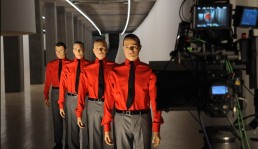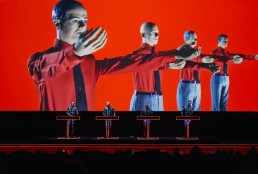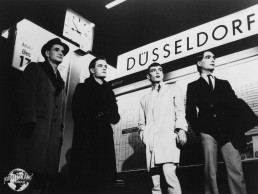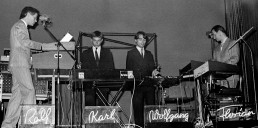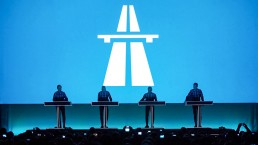As Kraftwerk prepare to take their man-machine music back on the road, their influential co-founder — speaking from the group’s secretive Kling Klang Studio in Germany — explains how technology took time to catch up with their ideas.
CALLING THE KLING Klang Studio, to interview Ralf Hütter, enigmatic co-founder of pioneering electronic music-makers Kraftwerk, is intimidating.
It’s daunting enough that Hütter is one of the most influential figures in pop and rarely gives interviews, but there are also whispers that the telephone I’ve been instructed to call at Kling Klang, on the outskirts of Düsseldorf — and from which Kraftwerk have been making music for more than 40 years — has no ringer and so will remain silent.
Precise instructions have emanated from the studio to call at 11.20am Central European Time, on the dot. Once connected, I will need to input a pre-arranged eight-digit access code. The interview slot will last exactly 15 minutes, to end abruptly at 11.35am.
It’s a great relief, therefore, to reach Hütter (at 11.21am) without any technical glitches. The cheerful-sounding 66-year-old is, he says, still on a high after Kraftwerk’s eight-night residency at the Turbine Hall of London’s Tate Modern art gallery in February.
And in May, Kraftwerk will bring their multi-media extravaganza of clinical, repetitive beats and addictive pop melodies — all synchronised to visual projections, choreographed robots and cutting-edge 3D animations — to Hong Kong.
DEMAND FOR KRAFTWERK’S The Catalogue 1 2 3 4 5 6 7 8 performances crashed the Tate Modern’s website within hours of 10,000 tickets going on sale. A retrospective of eight Kraftwerk albums, with one album performed on each day, the gigs received uniformly gushing reviews: “Perfect performance art” (Daily Telegraph); “Kraftwerk still feel unique” (Guardian); “Mesmerising … Phenomenal” (BBC).
“It was a fantastic environment,” Hütter says of the London concerts. “There were a lot of artistic connections because Kraftwerk means electronic energy, electric energy, and the Tate Modern’s Turbine Hall is an old kraftwerk.” His band’s name, Hütter points out, means power plant. “It’s an old, turbine-driven power station.”
Kraftwerk’s 3D performances, first unveiled at New York’s Museum of Modern Art in 2012, are the latest twist in the band’s four-decade-long career of pushing the limits of audio-visual technology.
Among the earliest users of electronic instruments, the four-piece combo’s signature sound has influenced bands and artists as diverse as the Human League, David Bowie, Bjork, Kanye West and Radiohead. In the run-up to the Tate Modern shows, Britain’s Observer newspaper described Kraftwerk as “still the world’s most influential band”, adding that “no other band since the Beatles has given so much to pop culture”.
KRAFTWERK’S MAN-MEETS-machine concept did not come about overnight. Hütter and original working partner Florian Schneider, who met as art students in Düsseldorf in the late 1960s, were just two of many homegrown musicians searching for a distinctively German sound and aesthetic that would differentiate them from American rock music and the popular British beat groups of the time.
Going by the name Organization, Hütter and Schneider experimented by mixing traditional music-making tools (notably Schneider’s flute, but also guitar, violin and other instruments, all processed with electronic effects) with primitive synthesisers and electric keyboards.
“We created a new electronic or contemporary, industrial, social musical language from zero. We didn’t have a language, so we created our own language”
Kraftwerk co-founder Ralf Hütter
Kraftwerk were formed in 1970 with the establishment of Kling Klang in Düsseldorf (the studio was relocated in 2009 to Meerbusch-Osterath, about 10 kilometres to the west). “We created a new electronic or contemporary, industrial, social musical language from zero,” says Hütter. “We didn’t have a language, so we created our own language.”
From the very beginning, Hütter says, the “Kraftwerk multi-media concept” was about much more than simply making orchestrated beeps, clanks and whirrs, and he frequently uses the word gesamtkunstwerk — which German composer Wilhelm Richard Wagner also employed, in the mid-19th century — to describe the bringing together of sound and visual media to create a “total artwork”.
“We played in galleries and arts centres more than in music [venues],” says Hütter, who has always been Kraftwerk’s prime source of lyrics. “We made videos, graphics, photographs, created album artwork … I am very much into words and tone poetry. Florian was into synthetic voices. Over the years, we worked with many different musicians, drummers, sound engineers and technicians, and today we are in 3D. It’s been a constant progression.”
KRAFTWERK’S BREAKTHROUGH came with 1974 album Autobahn. “It was our first electronic concept album — the beginning of what we call electro,” says Hütter, adding that Autobahn, logically, comes first in The Catalogue 1 2 3 4 5 6 7 8. “Before that we had three albums of transition from electro-acoustic music, with tapes and all kinds of experiments, but the first masterwork is Autobahn.”
From Autobahn through the album Trans-Europe Express (1977) to the single Tour De France (1983) and album Tour De France Soundtracks (2003), transportation has been a repeating theme.
“It’s not so much about travel, which means going from here to there,” says Hütter, who is an obsessive cyclist. “We are more interested in movement, continual movement, without any goals. ‘Dynamics’ is a better description. Social dynamics and changes in society. I think that’s the main theme of Kraftwerk music.”
Despite Kraftwerk’s cold, robotic image, fans also appreciate the sly humour in the band’s work. The track Autobahn’s lyrics (“Wir fahr’n, fahr’n, fahr’n auf der autobahn,” or “We drive, drive, drive on the autobahn”) have been called “a very Teutonic homage” to the Beach Boys’ Fun Fun Fun. The 1975 album Radio-Activity features a track called Ohm Sweet Ohm.
Kraftwerk on BBC TV's 'Tomorrow's World' in 1975. Video: The Kraftwerk Database/YouTube
HÜTTER CLAIMS THAT Kraftwerk’s roots in Germany’s Rhine area, with tribal-Germanic, French, Roman and other European cultural influences competing and cross-fertilising through the centuries, has been the reason. “Humour is part of our cultural cosmos,” he says.
To many ears, the name Kling Klang — which can be translated directly from German as “sounding sound” — sounds daft, resonating like an onomatopoeic “ding dong”. Kraftwerk’s private studio, however, is something that Hütter speaks of extremely seriously, almost with reverence.
“Kling Klang is a music machine,” says the self-described musikarbeiter, or “music worker”.
“It’s not a building — buildings don’t make music. It’s changing all the time, incorporating and connecting all our instruments, our synthesisers, our computers, our visuals, our graphics and animations.
“In the second part of the 1970s, we couldn’t do concerts, and then again after ’81, and all the way through the ’80s, because we couldn’t bring Kling Klang Studio with us. Everything was so complex. In the ’90s, with the digital age, we transformed Kraftwerk onto laptops. Now we can travel to cities like Hong Kong with the Kling Klang Studio going with us.”
“We would play Kling Klang Studio live, and there was always failure. Cables would break, knobs and switches would fall off, but we just kept going”
Ralf Hütter
Being ahead of their time, says Hütter, who is the last surviving member of Kraftwerk’s Autobahn line-up (Schneider left the band in 2009), proved a logistical nightmare whenever they attempted to take their music on the road. But Kraftwerk’s 1970s vision of the future is now pop music’s present
“We would play Kling Klang Studio live, and there was always failure,” he says. “Cables would break, knobs and switches would fall off, but we just kept going. Technology developed and now, with digital music machines and computer programs, it is at the level where the Kraftwerk concept works. The machines have finally caught up with us.”
HÜTTER IS LOOKING forward to Kraftwerk’s May shows in Hong Kong, in other Asian cities and at the Sydney Opera House in Australia. Until then he will labour at Kling Klang, reprogramming music, graphics and animations.
With the interview’s 11.35am deadline having passed (we speak for 21 minutes in total), Kraftwerk’s longest-serving man-machine — who has proven pleasingly human in conversation — wraps ups by considering his role as the elder statesman of electronic music, which he finds motivating.
“It’s a source of energy,” Hütter says. “The feedback from all generations of electronic musicians is so encouraging — it keeps me going. It’s like what I wrote in the lyrics for [Kraftwerk’s 1983 single] The Robots: ‘We’re charging our battery/And now we’re full of energy.’
“The feedback is doing exactly that.” ◉
An edited version ran in Hong Kong’s South China Morning Post in 2013. Download PDF.
SHARE


